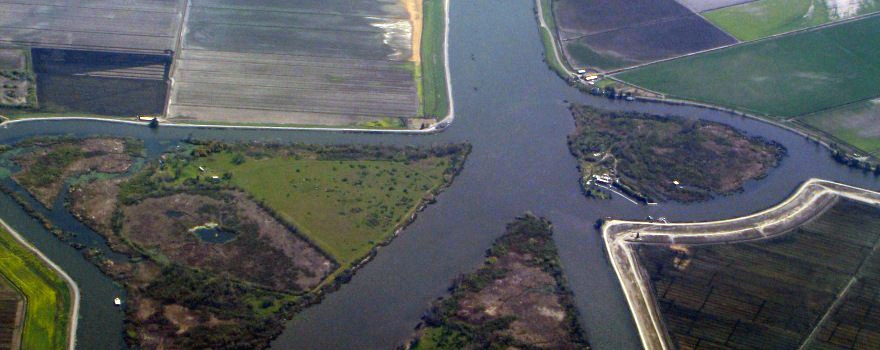 Water agencies say it’s infeasible; interest groups say it’s the most fairest and equitable approach
Water agencies say it’s infeasible; interest groups say it’s the most fairest and equitable approach
A broad coalition of environmental, fishing, environmental justice, and tribal organizations which includes Restore the Delta, the Planning and Conservation League, the NRDC, the California Sporfishing Protection Alliance and many others (herein referred to as the interest group coalition), has sent a letter to Felicia Marcus at the State Water Board, urging her to reject the demand by water agencies to abandon the ‘unimpaired flow’ approach to water management in the Delta currently being considered in the update of the State Board’s update to the Delta’s water quality control plan.
Unimpaired flow is defined as “the flow that would occur if all runoff from the watershed remained in the river, without storage in reservoirs or diversions, such as irrigation, power generation, or water supply.” The State Water Board process has been developing flow regimes for tributaries by establishing flow objectives that are a percentage of unimpaired flows in an attempt to approximate more natural flows for the benefit of salmon and other native species.
The interest group coalition is reacting to a July 23 letter sent by nineteen water agencies, including Metropolitan Water District and the State Water Contractors, that called on the State Water Board to abandon the unimpaired flow concept. In that letter, the water agencies wrote:
” …Four consecutive dry years have revealed the fallacy of attempting to mimic “unimpaired flows” to protect beneficial uses in present-day California. In fact, if the “unimpaired flow” approach was in place over the past five years, precious water resources would have already been drained from reservoirs throughout California before we entered these past several dry years. As a result, there would be even less water available in 2015 for the benefit of all beneficial uses, which includes cities and rural communities, fire suppression, cold water to sustain salmon, farms, birds and the Pacific Flyway, and recreational opportunities. Stated another way, an “unimpaired flow” approach would create greater risk for all beneficial uses during dry years. This dynamic would be further exacerbated under the various climate change scenarios evaluated by your administration. We cannot afford to go back in time and rely on defunct measures like an “unimpaired flow” approach for a system that has been highly altered over time. This type of approach will not improve the highly altered system and will only prove to deplete upstream reservoirs that all of California relies on. … “
Rather than using the unimpaired flow concept, the water agencies urge pursuing an approach to improve flow regimes through programs of implementation, such as strategic re-managed flows and other non-flow measures, such as addressing predation issues. Read the full letter from the water agencies by clicking here.
The interest group coalition disputes the claim that if the approach had been in place prior to the drought, that upstream reservoirs would have been drained, and instead contend poor water management is to blame. The interest group coalition writes:
“Drought sequences have occurred in forty-one of the last hundred years. The severity of drought has been exacerbated by water agencies making normal water deliveries in the first years of drought and continuing to deliver excessive quantities of water in subsequent drought years in the hope of future rainfall.
The SWRCB has reduced minimal flow and water quality standards established to protect fisheries thirty-five times during the present drought in order to conserve water for irrigated agriculture. These reductions have brought several pelagic and anadromous fish species to the precipice of extinction. Despite these actions, reservoir and groundwater levels are now at or approaching historic lows, and California is facing a disaster of epic proportions should the drought continue for another year. This has nothing to do with unimpaired flow. It has everything to do with an over-appropriated system and the failure of water agencies to embrace realistic delivery schedules with a margin of safety to protect against inevitable dry years. … “
The interest groups contend that recent modeling does show a percent-of-unimpaired flow approach is feasible, as well as the most equitable and fairest approach, as it asks for a fair-share commitment of flow from all tributary streams. They also note that the flow criteria that were developed in fulfillment of the mandate in the 2009 Delta Reform Act were based on a percentage of unimpaired flows and at the time, reflected a consensus opinion of scientists, fish agencies, and non-governmental organizations. To abandon the approach now and start over again as the water agencies request will only ensure additional years of delay on updating the water quality control plan, which is already years behind schedule, they say.
To read the letter from the interest group coalition, click here.
Programming note: Tomorrow and Wednesday, the Notebook will be covering the recent Mountain Counties Water Resources Association event on the Delta tunnels and the upstream impacts to the tributaries, where the State Water Board’s water quality control plan update and the impact on the upstream tributaries was quite a hot topic, so be sure to tune in tomorrow and Thursday …
 Get the Notebook blog by email and never miss a post!
Get the Notebook blog by email and never miss a post!
Sign up for daily emails and get all the Notebook’s aggregated and original water news content delivered to your email box by 9AM. Breaking news alerts, too. Sign me up!

